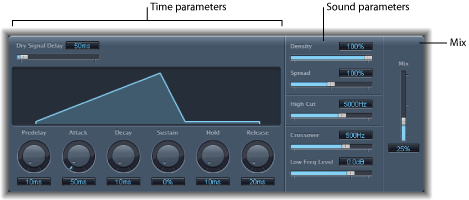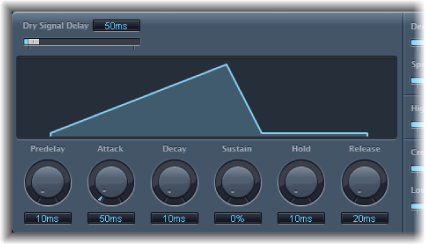EnVerb
EnVerb is a versatile reverb effect with a unique feature: It allows you to freely adjust the envelope—the shape—of the diffuse reverb tail.
The interface can be broken down into three areas:
EnVerb Time Parameters
EnVerb offers the following Time parameters:
Dry Signal Delay slider and field: Determines the delay of the original signal. You can hear the dry signal only when the Mix parameter is set to a value other than 100%.
Predelay knob and field: Sets the time between the original signal and the starting point of the reverb attack phase—the very beginning of the first reflection.
Attack knob and field: Defines the time it takes for the reverb to climb to its peak level.
Decay knob and field: Defines the time it takes for the level of the reverb to drop from its peak to the sustain level.
Sustain knob and field: Sets the level of the reverb that remains constant throughout the sustain phase. It is expressed as a percentage of the full-scale volume of the reverb signal.
Hold knob and field: Sets the duration—the time—of the sustain phase.
Release knob and field: Sets the time that the reverb takes to fade out completely, after it has completed the sustain phase.
EnVerb Sound Parameters
EnVerb offers the following tone control parameters:
Density slider and field: Sets the reverb density.
Spread slider and field: Controls the stereo image of the reverb. At 0% the effect generates a monaural reverb. At 200% the stereo base is artificially expanded.
High Cut slider and field: Frequencies above the set value are filtered out of the reverb tail.
Crossover slider and field: Defines the frequency that is used to split the input signal into two frequency bands, for independent processing.
Low Freq Level slider and field: Determines the relative level of (reverb signal) frequencies below the crossover frequency. In most cases you get better-sounding results when you set negative values for this parameter.


